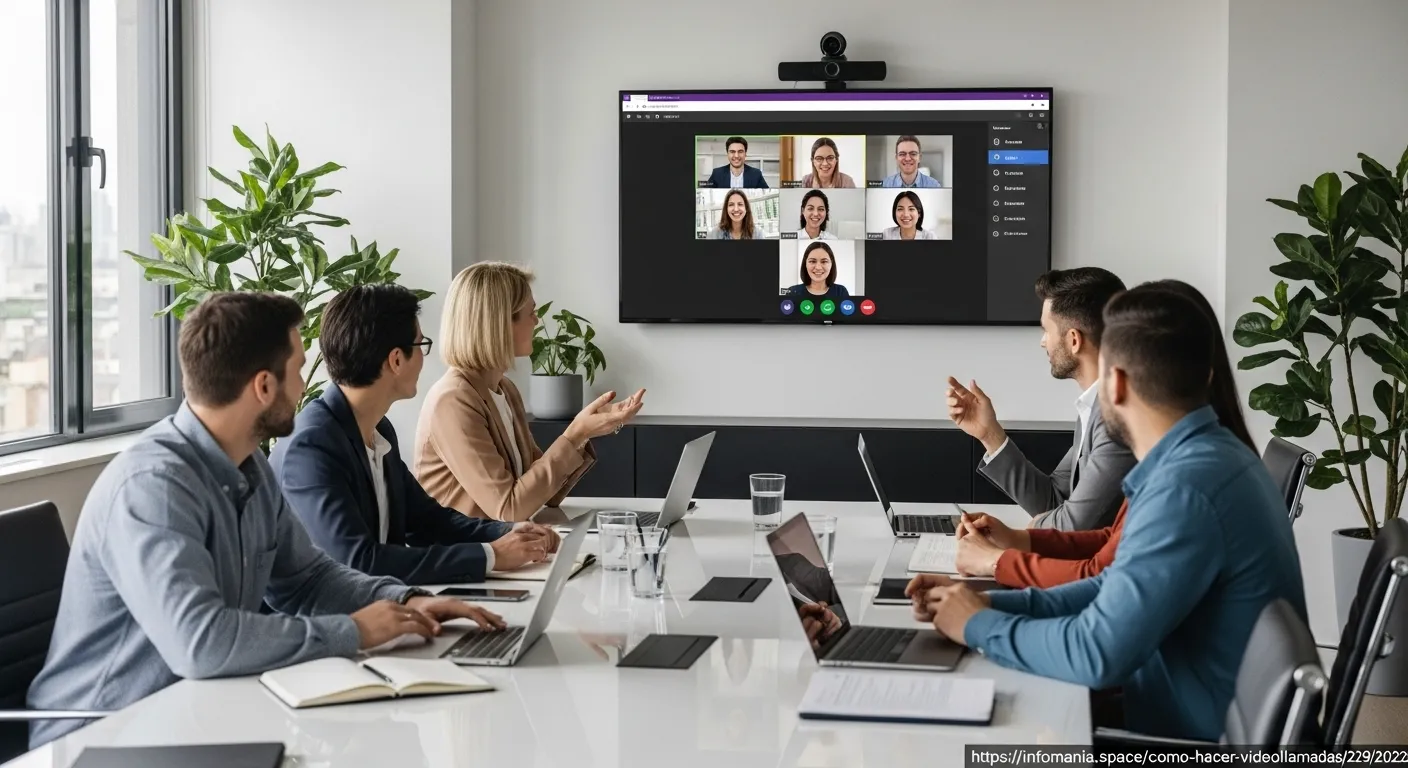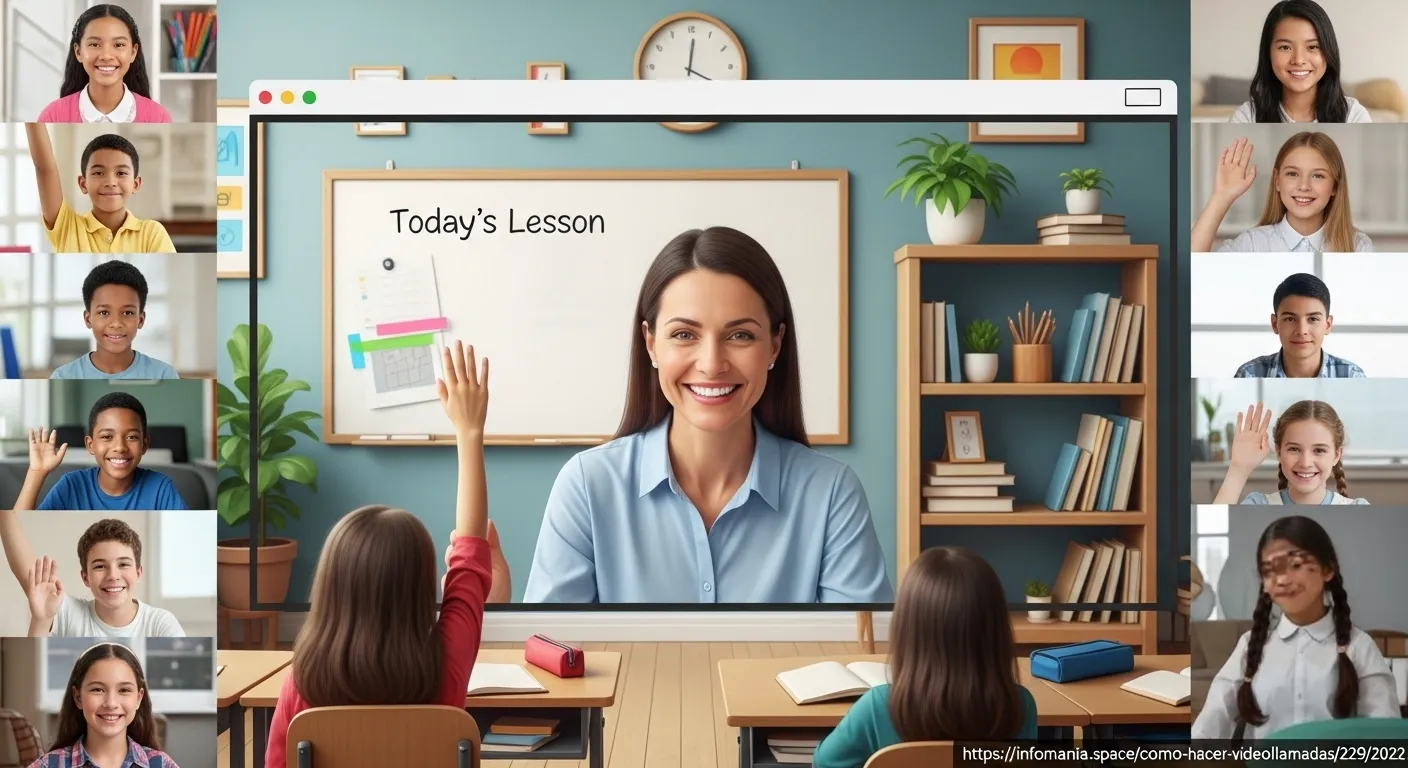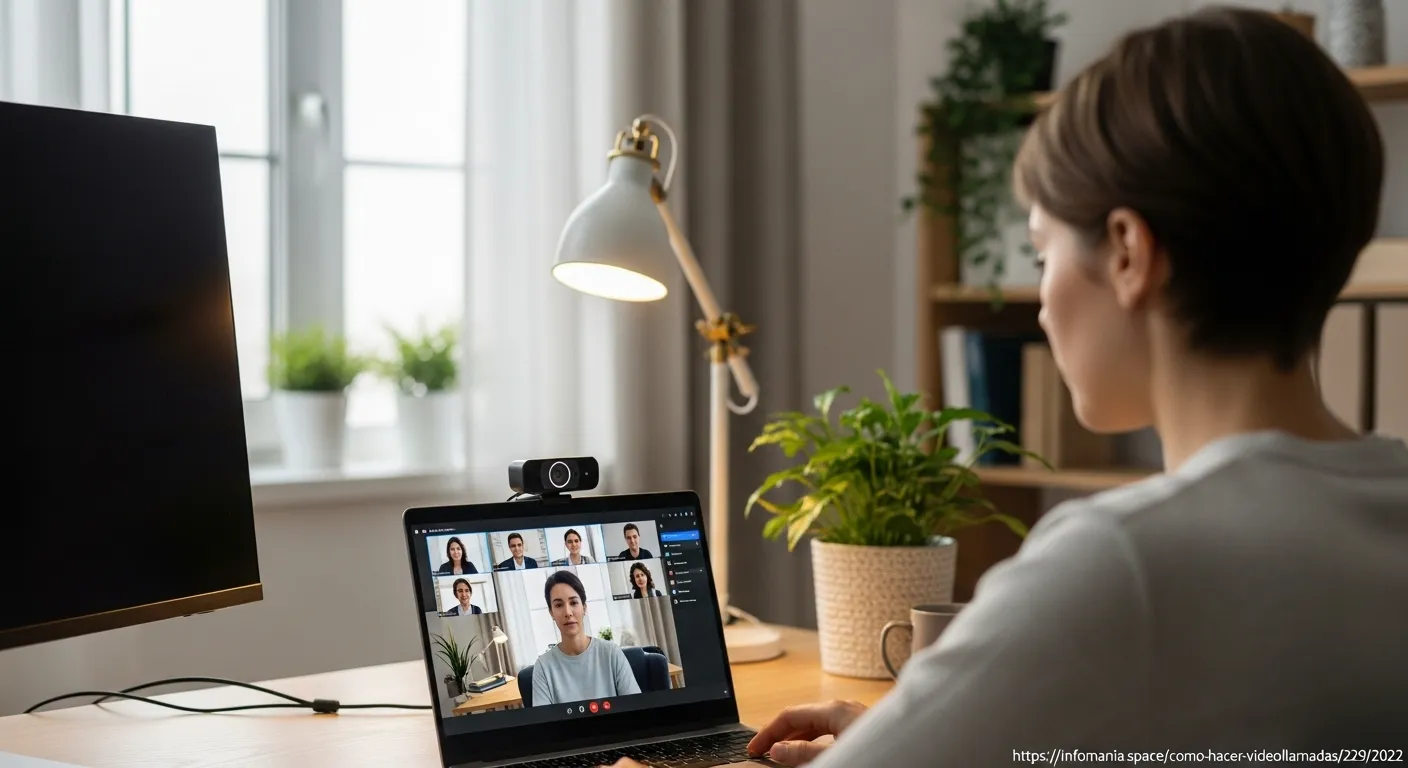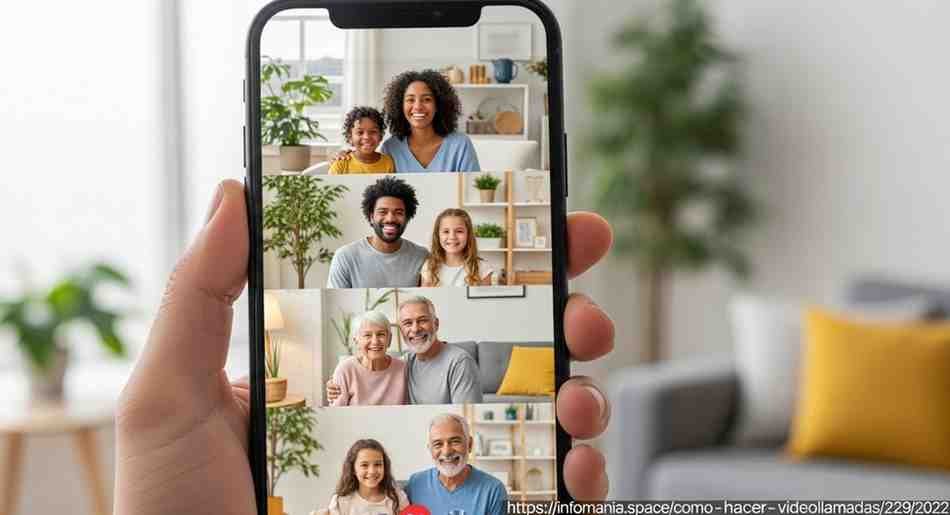Introduction: Why Video Calls Have Become Essential in Our Digital Lives
Remember when seeing someone’s face while talking to them seemed like science fiction?https://infomania.space/como-hacer-videollamadas/229/2022 . Today, video calls have become as natural as sending a text message. Whether you’re catching up with family across continents, attending a crucial business meeting from your home office, or joining an online class, hacer videollamadas (making video calls) has transformed from a luxury into an everyday necessity.
The COVID-19 pandemic accelerated this transformation dramatically. According to industry reports, video calling usage increased by over 500% between 2019 and 2021, and this trend shows no signs of slowing down. From remote workers conducting daily stand-ups to grandparents reading bedtime stories to their grandchildren thousands of miles away, video communication has bridged physical distances in unprecedented ways.
But if you’re new to this technology, the prospect of making your first video call might feel intimidating. Which app should you use? Do you need special equipment? How do you ensure good quality? What about privacy concerns?
This comprehensive guide answers all these questions and more. You’ll learn everything about videollamadas desde el ordenador
from computer) and videollamadas desde el móvil (video calls from mobile), discover the best platforms for different needs, master troubleshooting common issues, and gain confidence to make crystal-clear video calls like a professional.
By the end of this article, you’ll be equipped to connect face-to-face with anyone, anywhere in the world—all from the comfort of your chosen device.
What Are Video Calls and How Do They Work?
Understanding Video Call Technology
A video call, also known as a video chat or llamada de vídeo, is a real-time visual connection between two or more people using internet-enabled devices. Unlike traditional phone calls that transmit only audio, video calls simultaneously stream both video and audio signals, creating a face-to-face conversation experience despite physical separation.

The technology behind comunicación por internet involves several components working together:
- Capture: Your device’s cámara y micrófono (camera and microphone) capture your image and voice
- Encoding: This data is compressed into digital packets
- Transmission: These packets travel across the internet to the recipient’s device
- Decoding: The recipient’s device decompresses these packets
- Display: The video and audio are rendered on their screen and speakers
This entire process happens in milliseconds, creating the illusion of real-time interaction. Modern video calling apps use sophisticated algorithms to maintain quality even when internet speeds fluctuate, adjusting resolution and compression dynamically.
Why Video Calls Matter Today
The importance of video calling extends far beyond convenience:
For Remote Work and Teletrabajo: Video calls enable teams to maintain collaboration and company culture despite geographic separation. Visual cues like body language and facial expressions significantly improve communication compared to audio-only calls, reducing misunderstandings and building stronger professional relationships.
For Education and Clases en Línea: Teachers can conduct interactive lessons, demonstrate concepts visually, and maintain student engagement through video platforms. Students benefit from seeing their instructors and classmates, creating a more immersive learning experience than traditional distance education.
For Personal Connections: Families separated by distance can share meaningful moments—birthday celebrations, holiday gatherings, daily check-ins—maintaining emotional bonds that would otherwise weaken. Video calls allow grandparents to watch grandchildren grow up, couples in long-distance relationships to feel closer, and friends to stay connected despite busy schedules.
For Healthcare (Telemedicine): Medical consultations via video have expanded healthcare access, particularly for people in rural areas or with mobility challenges. Patients can receive professional medical advice without traveling, while doctors can visually assess symptoms and conditions.
Essential Requirements for Making Video Calls
Before diving into specific platforms and tutorials, let’s ensure you have everything needed for successful video calling.
Hardware Requirements
Camera:
- Built-in webcams: Most modern laptops, tablets, and smartphones include cameras suitable for video calls
- External webcams: Desktop computer users may need to purchase a USB webcam (prices range from $30-$150 for quality options)
- Resolution: Minimum 720p (HD) recommended; 1080p (Full HD) provides sharper images
Microphone:
- Built-in microphones: Adequate for basic calls but may pick up background noise
- Headset/earbuds with mic: Significantly improve audio quality and reduce echo
- External microphones: USB or dedicated mics offer professional-grade audio for frequent callers
Speakers/Headphones:
- Built-in speakers work but can create echo effects
- Headphones or earbuds provide clearer audio and prevent feedback
Display:
- Any screen capable of running video calling software works
- Larger screens (15″+ for computers, 5″+ for phones) enhance the experience
Internet Connection Requirements
A stable, reliable conexión estable de internet is the most critical requirement. Here are recommended speeds:
Minimum Requirements:
- One-on-one calls: 1 Mbps upload/download
- Group calls: 2-4 Mbps upload/download
- HD quality calls: 3-5 Mbps upload/download
Connection Types:
- Wi-Fi: Most convenient for home use; ensure strong signal strength
- Ethernet: Wired connections offer superior stability for computers
- Mobile Data: 4G/5G networks support video calls but consume significant data (approximately 1.5 GB per hour)
Testing Your Connection: Use online speed test tools (like Speedtest.net – nofollow link) to verify your internet speed before important calls.
Software Requirements
You’ll need a video calling application installed on your device. Popular options include:
- WhatsApp (nofollow link): Best for casual calls with existing contacts
- Zoom (nofollow link): Ideal for professional meetings and large groups
- Skype (nofollow link): Reliable for international calls and screen sharing
- Facebook Messenger (nofollow link): Convenient if you’re active on Facebook
- Google Meet (nofollow link): Excellent for Google Workspace users
Most apps are free for basic features, with premium subscriptions offering extended meeting times or additional participants.
How to Make Video Calls from Computer (Videollamadas desde el Ordenador)
Making videollamadas desde el ordenador offers advantages like larger screens, better multitasking, and often superior audio quality. Here’s how to get started.
Step-by-Step: Your First Computer Video Call
Step 1: Choose and Install Your Platform
Select an application based on your needs. For this tutorial, we’ll use Zoom as an example since it’s widely adopted for both professional and personal use.
- Visit the official Zoom website (nofollow link)
- Click “Sign Up, It’s Free” or “Download” in the top navigation
- Choose “Zoom Client for Meetings”
- Download the installer for your operating system (Windows/Mac/Linux)
- Run the installer and follow on-screen instructions
- Create a free account using your email address
Step 2: Configure Camera and Microphone
Before your first call, verify your equipment works correctly:
- Open Zoom application
- Click your profile icon (top right)
- Select “Settings”
- Navigate to “Video” tab
- You should see yourself in the preview window
- If not, click the camera dropdown and select your webcam
- Adjust “Touch up my appearance” and “Enable HD” as desired
- Navigate to “Audio” tab
- Click “Test Speaker” to verify audio output
- Click “Test Mic” and speak—you should see the input level indicator move
- Select appropriate devices from dropdowns if multiple options exist
Step 3: Initiate Your First Call
For scheduled meetings:
- Click “Schedule” button
- Fill in meeting details (topic, date, time, duration)
- Choose whether to enable video for host/participants
- Generate meeting link and share with participants via email or messaging
For instant meetings:
- Click “New Meeting” button with video on/off
- Click “Invite” once the meeting starts
- Copy the meeting link or directly invite contacts from your list
- Participants click the link to join
Step 4: During the Call
Familiarize yourself with essential controls (typically at bottom of screen):
- Mute/Unmute: Click microphone icon (or press Alt+A)
- Start/Stop Video: Click camera icon (or press Alt+V)
- Screen Share: Click “Share Screen” to show your display
- Participants: View and manage who’s in the call
- Chat: Send text messages during the call
- Leave: End your participation or end meeting for all
Computer Video Call Best Practices
Positioning:
- Place camera at eye level for natural viewing angles
- Sit approximately arm’s length from screen
- Ensure your face is well-centered in frame
Lighting:
- Face toward light sources (windows or lamps)
- Avoid backlighting (light behind you) which creates silhouettes
- Consider an inexpensive ring light for consistent illumination
Background:
- Choose clean, professional, or neutral backgrounds
- Use virtual backgrounds if your environment is cluttered
- Ensure nothing distracting appears behind you
Etiquette:
- Test audio/video before important calls
- Mute when not speaking in group calls
- Look at camera (not screen) when speaking for eye contact
- Minimize distractions and avoid multitasking
How to Make Video Calls from Mobile (Videollamadas desde el Móvil)
Videollamadas desde el móvil offer unparalleled convenience and portability. Here’s your complete mobile video calling guide.
Step-by-Step: Mobile Video Calls with WhatsApp
Videollamadas WhatsApp are among the most popular globally due to the app’s massive user base. Here’s how to use this feature:
Prerequisites:
- WhatsApp installed on your smartphone
- Active internet connection (Wi-Fi or mobile data)
- Phone number verified with WhatsApp
- Contact saved in your phone
Making a One-on-One Video Call:
- Open WhatsApp application
- Tap “Calls” tab at bottom of screen
- Tap phone icon with “+” symbol (top right)
- Select contact you want to call
- Tap video camera icon next to their name
- Wait for recipient to answer
Alternative method:
- Open existing chat with desired contact
- Tap video camera icon (top right of chat screen)
- Call initiates immediately
Making Group Video Calls:
For videollamadas grupales on WhatsApp:
- Open WhatsApp and tap “Calls” tab
- Tap new call button (phone with +)
- Select “New Group Call”
- Choose up to 7 participants (8 people total including you)
- Tap video icon to start group video call
During the Call:
- Flip camera: Tap camera flip icon to switch between front/rear cameras
- Mute audio: Tap microphone icon to mute/unmute
- Disable video: Tap camera icon to turn video on/off
- Add participants: Tap “Add participant” icon (group calls only)
- End call: Tap red phone icon
Mobile Video Call Tips
Data Management:
- Use Wi-Fi whenever possible to avoid excessive mobile data charges
- One hour of video calling consumes approximately 1.5GB of data
- Reduce video quality in WhatsApp settings if concerned about data usage
Battery Conservation:
- Video calls drain battery quickly—ensure adequate charge
- Consider plugging in during extended calls
- Close background apps to maximize battery life
Stability:
- Find stable surface or use phone stand
- Avoid walking during calls to prevent shaky video
- Ensure strong signal strength before important calls
Privacy:
- Find quiet, private location for confidential calls
- Use headphones in public spaces
- Be aware of your surroundings and what’s visible in background

Comprehensive Platform Guide: Popular Video Calling Applications
Let’s explore the most popular aplicaciones para videollamadas in detail, helping you choose the best platform for your specific needs.
WhatsApp Video Calls
Best For: Casual personal calls with friends and family
Key Features:
- End-to-end encryption for maximum privacy
- Seamless integration with existing chat conversations
- Simple, intuitive interface
- Works on smartphones and desktop (with limitations)
- Support for group calls up to 8 participants
Pros:
- Most contacts likely already have WhatsApp
- Videollamadas gratis without time limits
- Excellent security and privacy
- Low learning curve
Cons:
- Limited to 8 participants for group calls
- Desktop version has limited functionality
- Requires phone number for registration
- Video quality depends heavily on internet connection
How to Get Started:
- Download WhatsApp from App Store or Google Play (nofollow link)
- Verify your phone number
- Sync contacts automatically
- Start calling immediately
Zoom Video Calls
Best For: Professional meetings, webinars, online classes, and large group gatherings
Key Features:
- Supports up to 100 participants (free plan) or 1,000+ (paid plans)
- Screen sharing with annotation tools
- Virtual backgrounds and beauty filters
- Recording capabilities
- Breakout rooms for small group discussions
- Scheduling and calendar integration
Pros:
- Industry-standard for reuniones online and teletrabajo
- Excellent video and audio quality
- Robust features for collaboration
- Cross-platform compatibility (computer, mobile, tablet)
- Free plan includes most essential features
Cons:
- Free plan limits meetings to 40 minutes with 3+ participants
- Requires app download (though browser version exists)
- Can feel overwhelming with numerous features
- Past security concerns (though addressed)
How to Get Started:
- Visit Zoom website and create free account (nofollow link)
- Download appropriate app for your device
- Schedule or start instant meetings
- Share meeting link with participants
Skype Video Calls
Best For: International calls, interviews, and flexible personal/professional use
Key Features:
- No time limits on videollamadas gratis
- Support for up to 50 participants
- Screen sharing and file transfer during calls
- Call recording built-in
- Integration with Microsoft ecosystem
- Ability to call regular phone numbers (paid feature)
Pros:
- Established, reliable platform (been around since 2003)
- Unlimited free video call duration
- Works on virtually any device or platform
- Background blur feature
- Subtitles and live captions available
Cons:
- Less popular than competitors for business use
- Interface can feel dated
- Requires Microsoft account
- Occasional audio/video sync issues
How to Get Started:
- Visit Skype website (nofollow link)
- Download app or use web version
- Sign in with Microsoft account (or create one)
- Add contacts via Skype name, email, or phone number
Google Meet
Best For: Google Workspace users, educators, and collaborative work
Key Features:
- Seamless integration with Google Calendar and Gmail
- Up to 100 participants (free plan)
- Screen sharing and presentation mode
- Live captions powered by AI
- Adjustable layouts and grid views
- Noise cancellation technology
Pros:
- No software installation required (runs in browser)
- Excellent integration with Google services
- Strong security and compliance features
- Simple, clean interface
- Free for personal use with generous limits
Cons:
- Free plan limits meetings to 60 minutes (though often extended)
- Best experience requires Chrome browser
- Fewer features than Zoom for specialized use cases
- Limited customization options
How to Get Started:
- Visit meet.google.com (nofollow link)
- Sign in with Google account
- Click “New meeting” or “Join a meeting”
- Share meeting link via email or calendar invite
Facebook Messenger Video Calls
Best For: Spontaneous calls with Facebook friends
Key Features:
- Instant calls with Facebook contacts
- Support for up to 50 participants
- Augmented reality effects and filters
- Screen sharing capability
- Works on mobile and desktop
- Integration with Facebook social features
Pros:
- No separate account needed if you have Facebook
- Fun filters and effects for casual calls
- Convenient for staying connected with social network
- Cross-platform functionality
Cons:
- Privacy concerns associated with Facebook platform
- Limited professional features
- Video quality sometimes inconsistent
- Requires Facebook account
How to Get Started:
- Open Facebook or download Messenger app (nofollow link)
- Navigate to Messenger section
- Select contact and tap video icon
- Start calling immediately
Mastering Group Video Calls (Videollamadas Grupales)
Videollamadas grupales require additional consideration to ensure smooth experiences for all participants.
Planning Successful Group Calls
Choose the Right Platform:
- Small groups (2-8 people): WhatsApp works well for casual gatherings
- Medium groups (8-25 people): Zoom or Google Meet offer better management
- Large groups (25+ people): Zoom or Microsoft Teams provide necessary controls
- Webinars/presentations: Zoom webinar mode or YouTube Live for one-to-many communication
Schedule Appropriately:
- Send calendar invites with meeting link well in advance
- Consider time zones if participants are geographically distributed
- Provide clear agenda for professional calls
- Estimate realistic duration and communicate it
Set Ground Rules:
- Establish muting guidelines (mute when not speaking)
- Define speaking order for structured discussions
- Decide on video-on expectations
- Clarify recording permissions
Managing Group Call Dynamics
As Host:
- Start meeting 5 minutes early to resolve technical issues
- Welcome participants as they join
- Designate someone to take notes if needed
- Use “mute all” feature for large groups
- Monitor participant list for attendees
- Manage speaking turns to prevent talking over each other
As Participant:
- Join on time (preferably 2-3 minutes early)
- Test audio/video before joining
- Mute yourself when not speaking
- Use “raise hand” feature to signal you want to speak
- Avoid side conversations in chat during presentations
- Stay engaged and minimize distractions

Enhancing Group Call Quality
Audio Management:
- Encourage headphone use to prevent echo
- Mute participants with background noise
- Use noise cancellation features when available
- Speak clearly and at moderate pace
Video Optimization:
- Suggest participants use video when possible for engagement
- Allow video-off option for bandwidth conservation
- Use gallery view to see all participants
- Pin speaker video during presentations
Engagement Strategies:
- Use polls and reactions to gauge feedback
- Leverage breakout rooms for smaller discussions
- Share screen for visual presentations
- Use virtual backgrounds to maintain consistency
Improving Your Video Call Quality (Calidad de Audio y Vídeo)
Achieving professional calidad de audio y vídeo significantly enhances your video calling experience.
Optimizing Video Quality
Lighting Techniques:
Proper lighting is the single most impactful improvement you can make:
- Natural lighting: Position yourself facing windows during daytime
- Three-point lighting: Use key light (main), fill light (softens shadows), and back light (separates you from background)
- Ring lights: Affordable option ($20-$100) providing even, flattering illumination
- Avoid overhead lighting: Creates unflattering shadows under eyes and nose
- Test before calls: Join meetings early to verify lighting
Camera Positioning:
Strategic camera placement creates more engaging video:
- Eye level: Position camera at or slightly above eye level
- Distance: Sit approximately arm’s length away
- Framing: Follow the “rule of thirds”—position your eyes in the top third of frame
- Background: Ensure 1-2 feet of space above your head
- Stability: Use laptop stand or external webcam on stable surface
Internet Optimization:
Maximize your conexión estable de internet:
- Wired connection: Use Ethernet cable when possible for stability
- Router proximity: Stay close to Wi-Fi router or consider mesh network
- Bandwidth management: Close unnecessary applications and browser tabs
- Limit concurrent users: Ask household members to pause heavy downloads during calls
- Upgrade plan: Consider faster internet if regularly experiencing issues
Enhancing Audio Quality
Clear audio is more important than perfect video for effective communication.
Microphone Best Practices:
- External microphones: Invest in USB microphone ($50-$150) for dramatically better audio
- Headset position: Keep microphone 2-3 inches from mouth
- Avoid touching: Don’t touch or adjust microphone during calls
- Test levels: Ensure volume isn’t too quiet or distorting from being too loud
Environment Control:
- Choose quiet rooms: Avoid spaces with appliance noise, traffic, or echo
- Soft furnishings: Carpets, curtains, and furniture absorb sound and reduce echo
- Close doors/windows: Minimize external noise
- Inform household: Request quiet during important calls
- Use push-to-talk: Some apps offer this feature to prevent breathing sounds
Software Settings:
Most platforms offer audio enhancement features:
- Noise suppression: Filters background sounds
- Echo cancellation: Prevents feedback loops
- Automatic gain control: Normalizes volume levels
- Original sound (Zoom): Preserves audio quality for music/performances
Privacy, Security, and Safety for Video Calls
Understanding privacidad y seguridad (privacy and security) protects you from potential risks.
Essential Security Practices
Account Security:
- Use strong, unique passwords for video calling accounts
- Enable two-factor authentication where available
- Never share meeting passwords publicly
- Log out from shared devices after use
Meeting Protection:
- Use waiting rooms: Approve participants before they join
- Enable passwords: Require password for meeting access (especially for Zoom)
- Unique meeting IDs: Generate new ID for each call rather than using personal meeting room
- Lock meetings: Prevent new participants from joining once everyone has arrived
- Control screen sharing: Restrict who can share screens to prevent hijacking
Data Privacy:
- Understand privacy policies: Know how each platform handles your data
- End-to-end encryption: Prefer platforms offering this (like WhatsApp)
- Recording disclosure: Always inform participants if recording
- Secure recordings: Store recordings with password protection
- Regular updates: Keep apps updated for latest security patches
Protecting Your Privacy
Visual Privacy:
- Background awareness: Ensure nothing confidential is visible behind you
- Virtual backgrounds: Use these to obscure your actual location
- Blur background: Alternative to virtual backgrounds
- Camera covers: Use sliding covers when camera isn’t in use
Audio Privacy:
- Location selection: Avoid public spaces for confidential calls
- Headphone use: Prevents others nearby from hearing conversation
- Mute when appropriate: Protects against accidentally broadcasting private sounds
Information Protection:
- Screen sharing caution: Close sensitive documents before sharing screen
- Notification privacy: Disable notifications during screen sharing
- Chat discretion: Remember chat messages may be recorded or saved
Troubleshooting Common Video Call Problems
Even with perfect preparation, technical issues can arise. Here’s how to diagnose and fix common problems.
Audio Issues
Problem: No one can hear you
Solutions:
- Check if you’re muted in the app
- Verify microphone isn’t muted at system level (Windows/Mac sound settings)
- Test with different microphone if available
- Close and restart the application
- Check app permissions (especially on mobile devices)
Problem: You can’t hear others
Solutions:
- Check speaker/headphone volume levels
- Verify correct audio output device is selected
- Test with different speakers/headphones
- Restart application or device
- Check if audio is routed to incorrect output (Bluetooth device, etc.)
Problem: Echo or feedback
Solutions:
- Ask all participants to use headphones
- Mute when not speaking
- Move microphone further from speakers
- Enable echo cancellation in app settings
- Reduce speaker volume

Video Issues
Problem: Camera not working
Solutions:
- Verify camera isn’t being used by another application
- Check app permissions for camera access
- Select correct camera in app settings (if multiple cameras)
- Restart computer or phone
- Update camera drivers (Windows/Mac)
- Try different USB port (external webcams)
Problem: Poor video quality or freezing
Solutions:
- Test internet speed—may need to reduce video quality
- Close bandwidth-intensive applications
- Move closer to Wi-Fi router
- Switch to wired Ethernet connection
- Ask others on network to pause downloads
- Reduce video resolution in app settings
- Turn off HD video temporarily
Problem: Video lagging behind audio
Solutions:
- Indicates internet connectivity issues—test speed
- Close unnecessary browser tabs and applications
- Restart router
- Switch from Wi-Fi to cellular data (or vice versa)
- Leave and rejoin the call
Connection Issues
Problem: Can’t join meeting
Solutions:
- Verify meeting link or ID is correct
- Check if meeting password is required
- Ensure app is updated to latest version
- Try joining from web browser instead of app
- Check if host has enabled waiting room
- Verify your account has necessary permissions
Problem: Frequently disconnected
Solutions:
- Test internet stability—may need to upgrade plan
- Reduce video quality to consume less bandwidth
- Turn off video temporarily (audio-only)
- Move to location with better signal
- Restart router/modem
- Switch networks if available
Real-World Applications: Video Calls in Action
Understanding practical scenarios helps you appreciate how hacer videollamadas enhances various aspects of life.
Case Study 1: Remote Work Transformation
Scenario: Sarah’s Distributed Marketing Team
Sarah manages a marketing team of 12 professionals across four countries. Before adopting structured video calling practices, her team struggled with miscommunication and felt disconnected.
Implementation:
- Daily stand-ups: 15-minute Zoom calls each morning to align priorities
- Weekly team meetings: Hour-long sessions with screen sharing for presentations
- One-on-ones: Bi-weekly 30-minute video conversations with each team member
- Virtual coffee breaks: Informal Friday afternoon calls for social connection
Results:
- 35% improvement in project completion rates
- 90% of team members reported feeling more connected to colleagues
- Reduced email volume by 40% as quick questions were resolved via video
- Client satisfaction increased due to better internal coordination
Key Takeaway: Structured video calling routines maintain team cohesion and productivity in remote work environments.
Case Study 2: Long-Distance Education
Scenario: Professor Martinez’s Online University Course
Professor Martinez teaches psychology to 45 students via Google Meet. Initially, engagement was low, with students leaving cameras off and rarely participating.
Changes Implemented:
- Breakout rooms: Small group discussions every 20 minutes
- Virtual office hours: Three scheduled times weekly for individual consultations
- Screen sharing demonstrations: Visual aids for complex concepts
- Collaborative whiteboards: Real-time participation tools
- Recorded lectures: Posted for students in different time zones
Results:
- Student participation increased from 20% to 75%
- Course satisfaction ratings rose from 3.2 to 4.5 out of 5
- Final exam scores improved by an average of 12%
- Attendance rates exceeded in-person course averages
Key Takeaway: Interactive features in video calling platforms can create engaging clases en línea comparable to traditional classrooms.
Case Study 3: Family Connection Across Continents
Scenario: The Rodriguez Family
The Rodriguez family is spread across Spain, Argentina, and the United States. Before using video calls regularly, they maintained contact primarily through text messages, leading to feelings of disconnection.
New Routine:
- Monthly family gatherings: 90-minute WhatsApp group calls with all 15 family members
- Grandparent-grandchild story time: Twice-weekly 20-minute calls for grandparents to read to young children
- Birthday celebrations: Special calls with virtual backgrounds and celebration themes
- Holiday traditions: Video-calling during family dinners to “eat together” despite distance
Impact:
- Children developed stronger relationships with grandparents
- Family members felt emotionally closer despite physical distance
- Reduced feelings of isolation, particularly for elderly grandparents
- Created new family traditions adapted to digital age
Key Takeaway: Regular videollamadas grupales maintain family bonds across geographical boundaries, particularly important for multi-generational families.
Pros and Cons of Video Calling: An Honest Assessment
Understanding both advantages and limitations helps set realistic expectations.
Advantages of Video Calls
1. Visual Communication Enhances Understanding
Seeing facial expressions, body language, and gestures provides context that audio-only communication lacks. Studies show that 55% of communication is non-verbal, making video essential for complete understanding.
2. Flexibility and Convenience
Connect from anywhere with internet access—home, office, café, or while traveling. No need for commuting to physical locations saves time and reduces stress.
3. Cost-Effective Communication
Most platforms offer videollamadas gratis for basic features. International calls that would cost substantial amounts via traditional phone services are now free over internet connections.
4. Strengthens Relationships
Whether personal or professional, face-to-face interaction (even virtual) builds stronger connections than text or audio alone. Particularly important for maintaining remote relationships.
5. Increases Productivity
Quick video call often resolves issues faster than lengthy email chains. Screen sharing enables collaborative problem-solving in real-time, accelerating project progress.
6. Environmental Benefits
Reducing travel for meetings decreases carbon emissions. Organizations adopting video conferencing significantly reduce their environmental footprint.
7. Documentation and Learning
Recording capabilities allow review of meetings, training sessions, or important conversations. Valuable for training materials and institutional knowledge preservation.
8. Accessibility Features
Closed captions, screen readers, and visual communication options make video calls more accessible for people with hearing or speech differences compared to phone calls.
Disadvantages and Limitations
1. Technology Dependence
Requires reliable internet, functioning equipment, and technical literacy. Technical failures can disrupt important communications at critical moments.
2. Screen Fatigue
“Zoom fatigue” is real—prolonged video calling causes mental exhaustion. The constant self-awareness and intense focus on screens is draining.
3. Reduced Spontaneity
Unlike in-person interactions, video calls require scheduling and setup. Casual “hallway conversations” that spark creativity are harder to replicate virtually.
4. Privacy and Security Risks
Potential for unauthorized access, recording without consent, or data breaches. Not all platforms provide equivalent security levels.
5. Limited Context
You only see what’s in the camera frame. Missing the fuller physical environment and surrounding context can lead to misinterpretations.
6. Internet Inequality
People in areas with poor connectivity or those who can’t afford high-speed internet face disadvantages, creating digital divides.
7. Non-Verbal Communication Gaps
Despite seeing faces, subtle body language cues are harder to read. Camera angles, lighting, and technical quality can obscure nuanced expressions.
8. Professionalism Pressures
Expectation to maintain appearance, appropriate backgrounds, and “camera-ready” status creates stress. Home environments may not always be suitable for professional calls.
Overcoming the Disadvantages
Combat Screen Fatigue:
- Schedule breaks between calls
- Use audio-only for less critical meetings
- Limit camera-on time to portions where it adds value
- Practice the 20-20-20 rule: every 20 minutes, look at something 20 feet away for 20 seconds
Enhance Security:
- Use platforms with end-to-end encryption
- Implement meeting passwords and waiting rooms
- Regularly update software
- Educate team members on security best practices
Improve Accessibility:
- Ensure adequate internet for all team members
- Provide equipment stipends for remote workers
- Offer flexible call times accommodating different time zones
- Record sessions for those who can’t attend live
Maintain Human Connection:
- Schedule informal virtual social time
- Enable camera-off options to reduce pressure
- Vary meeting formats to maintain engagement
- Supplement video with other communication methods

Frequently Asked Questions About Video Calls
1. How do I make video calls from my PC without downloading software?
Many platforms offer browser-based options that don’t require installation. Google Meet works entirely in web browsers, Skype offers a web version called “Skype for Web,” and Zoom has a browser version (though the app provides better performance). Simply visit the platform’s website, join or start a meeting, and allow browser access to your camera and microphone when prompted.
2. Which app is best for free video calls with no time limit?
WhatsApp and Skype offer unlimited free video calls with no time restrictions. Facebook Messenger also provides unlimited calling for personal use. Zoom‘s free plan limits group calls (3+ participants) to 40 minutes but allows unlimited one-on-one calls. For completely unrestricted free use, WhatsApp or Skype are your best options.


